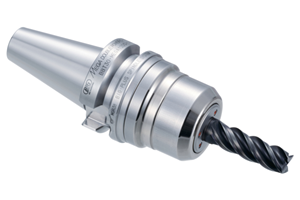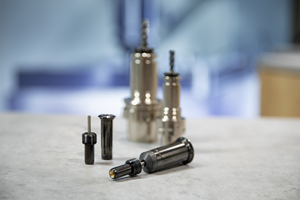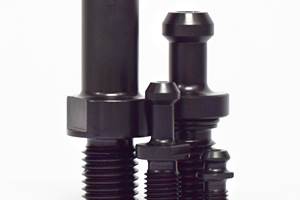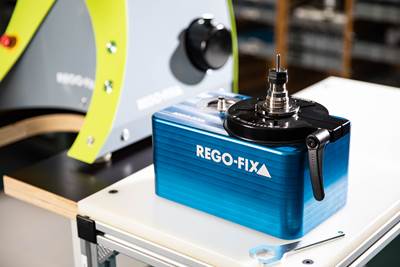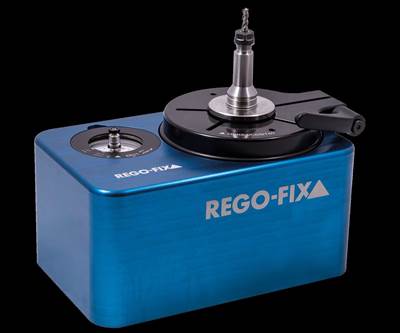Share






Rego-Fix launched PowRgrip as a high-performance tooling system including toolholders, collets and clamping units that could handle tools ranging from 20 millimeters down to 3 millimeters. In the 20 years since, Rego-Fix has expanded the product line to keep up with changes in the manufacturing industry. Photo provided by MMS.
When Rego-Fix first launched its PowRgrip tooling system in the early 2000s, it was a collection of toolholders, collets and clamping units that could handle tools ranging from 20 millimeters to 3 millimeters. But as the manufacturing landscape has changed over the past 20 years, PowRgrip has evolved with it. The company initially promoted it as a high-performance system, but the addition of automation can make tool assembly even more efficient. At the same time, manufacturers need highly accurate tools in a wider range of sizes. “As the market has changed, it's not only become a high-performance system, but it has also become a high-precision system,” says David McHenry, engineering and Machining Center of Excellence manager at Rego-Fix. “We're able to do the very difficult heavy roughing and hard machining all the way down to the really small, fine drills and machine work that we're seeing.”

As the need for automation has grown, Rego-Fix has developed several robotically automated tool assembly systems. It has also incorporated tool presetters into automated cells, as this demonstration shows. Photo provided by MMS.
1. From Easy to Automated Tool Assembly
PowRgrip was designed to make tool assembly easier and require less training than traditional methods. “You don't have to have highly trained machinists to be able to put it together,” McHenry explains. “Users can keep their highly trained machinists running their machines, doing the programs, doing what's important for their shop.” This ease of use also enables the system to be automated with a robot. The system started as a demo for IMTS in 2018, and Rego-Fix received a lot of positive responses about it from shops who were having trouble finding employees. “That kind of started the spark that people are interested in this,” he says. “It's not just a little novelty to draw people in at the trade show. It's actually a need.” Since then, the company has gone through several iterations of the automatable PowRgrip system, including pneumatically and electronically controlled versions, which users can integrate into a cell that fits their needs. The company is also working on incorporating tool presetters into automated cells. A demonstration of this was on display at IMTS 2024 and was running in the company’s new Center of Machining Excellence.

The semiconductor industry is helping drive smaller, high-precision machining. In response, Rego-Fix launched the PG 6, a PowRgrip system designed to handle tools ranging from 4 millimeters to 0.2 millimeters. Photo provided by Rego-Fix.
2. Smaller Tools
McHenry partly attributes an increased demand for smaller cutting tools to the semiconductor industry. “We are definitely seeing a trend in high-precision machining,” he says. “Lots of people getting into or improving their processes for memory chips or computer processors.” These parts require very small tools, in the range of eight to twelve thousandths of an inch in diameter, which the original PowRgrip system was not equipped to handle. “Three millimeters didn't quite cut it for that really small micromachining that we're talking about now,” he continues. The company released a smaller PowRgrip system, the PG 6, which can handle tools ranging from 4 millimeters to 0.2 millimeters. Not only does it make assembling high-precision tools much easier, it also has vibration damping properties, which is critical in micromachining applications.

Rego-Fix is also seeing customers in the spaceflight industry request larger-diameter tools. The PowRgrip PG 48 can handle tools as large as 1.5 inches in diameter for applications with high material removal rates. Photo provided by MMS.
3. Bigger Tools
At the same time, McHenry says Rego-Fix is also seeing demand in the opposite direction. “We do a lot of work for companies that send things into space, and one of the things they've asked for is much bigger diameter tools,” he notes. These tools are used in applications with high material removal, such as heavy roughing. In response to these requests, Rego-Fix released the PG 48, which can handle tools as large as 1.5 inches in diameter. “It’s a totally new PowRgrip series, and it's dedicated just to those super large, heavy roughing tools,” he adds.
According to McHenry, PowRgrip’s expansion is intended to bring accurate and simple tool assembly to a wider range of applications. “Not only do tools need to have the precision, but they need simplicity for putting it all together,” he says.
Related Content
Big Daishowa Chuck Eliminates Chatter in Milling Operations
The Mega 12DS chuck is designed for trochoidal milling with anti-vibration end mills.
Read MoreRego-Fix Toolholding System Reduces Coolant Consumption
MQL PG collets are designed for machines using one-channel, internal through-spindle MQL systems.
Read MoreThrough-Coolant System Cuts Nickel-Alloy Cycle Times by 70%
Decker Machine Works recently adopted Rego-Fix’s reCool through-coolant system for ER collets, reducing the cycle times on a nickel alloy job by 70%.
Read MoreT.J. Davies Retention Knobs Maximize Cutting Tool Life
Custom-made retention knobs are sized to fit the machine tool and spindle or toolholder to extend the life of existing machine tool assets.
Read MoreRead Next
Five Common Mistakes Shops Make with ER Collets (And How to Prevent Them)
Collets play a crucial role in the machining process, so proper tool assembly and maintenance is important. Here are five potential pitfalls to avoid when using ER collets.
Read MoreThrough-Coolant System Cuts Nickel-Alloy Cycle Times by 70%
Decker Machine Works recently adopted Rego-Fix’s reCool through-coolant system for ER collets, reducing the cycle times on a nickel alloy job by 70%.
Read MoreWhat If You Don’t Have a Torque Wrench?
This device ensures that ER collets are torqued to the proper value using any type of wrench.
Read More


















.jpg;maxWidth=300;quality=90)





